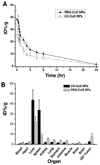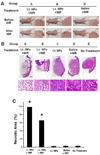A chelator-free multifunctional [64Cu]CuS nanoparticle platform for simultaneous micro-PET/CT imaging and photothermal ablation therapy
- PMID: 20942456
- PMCID: PMC2966020
- DOI: 10.1021/ja106855m
A chelator-free multifunctional [64Cu]CuS nanoparticle platform for simultaneous micro-PET/CT imaging and photothermal ablation therapy
Abstract
We synthesized and evaluated a novel class of chelator-free [(64)Cu]CuS nanoparticles (NPs) suitable both for PET imaging and as photothermal coupling agents for photothermal ablation. These [(64)Cu]CuS NPs are simple to make, possess excellent stability, and allow robust noninvasive micro-PET imaging. Furthermore, the CuS NPs display strong absorption in the near-infrared (NIR) region (peak at 930 nm); passive targeting prefers the tumor site, and mediated ablation of U87 tumor cells occurs upon exposure to NIR light both in vitro and in vivo after either intratumoral or intravenous injection. The combination of small diameter (∼11 nm), strong NIR absorption, and integration of (64)Cu as a structural component makes these [(64)Cu]CuS NPs ideally suited for multifunctional molecular imaging and therapy.
Figures





References
Publication types
MeSH terms
Substances
Grants and funding
LinkOut - more resources
Full Text Sources
Other Literature Sources
Medical
Miscellaneous

